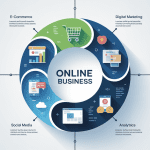
Breaking the value-cost trade-off is about finding ways to deliver high value to customers without significantly increasing your costs.
Traditionally, businesses have had to choose between differentiation and low cost—either offering something unique that comes with a higher price tag or lowering costs to make a product more accessible, often by sacrificing quality or special features.
The goal of breaking this trade-off is to find a way to achieve both: delivering differentiated, high-quality offerings while keeping expenses in check.
With AI, this balance becomes possible by enabling you to streamline operations, cut down production costs, and automate repetitive tasks, all of which allow you to focus resources on creating more valuable offerings without a corresponding increase in expenses.
AI can help you differentiate your products or services by allowing you to add unique features or customization options without dramatically increasing production costs.
At the same time, AI can simplify and optimize back-end processes, reducing the operational load and making it possible to offer these differentiated features at an affordable price.
Essentially, AI enables you to do more with less—more personalization, more efficiency, more product innovation—while keeping your costs manageable and maintaining accessibility for a wider audience.
One effective way AI supports breaking the value-cost trade-off is by automating repetitive tasks that don’t add direct value to the customer but are necessary for your business operations.
Tasks like inventory management, data entry, customer support, and even some aspects of marketing can consume a lot of time and resources, yet they are essential to keep the business running smoothly.
AI-powered tools like chatbots, CRM systems, and predictive analytics can take over many of these processes, freeing up your team to focus on higher-value tasks, such as product development and customer engagement.
For instance, AI chatbots can handle common customer inquiries, reducing the workload on your support team while providing instant responses for customers.
This means you can maintain excellent service without expanding your support staff, a cost-effective way to enhance customer satisfaction.
Here are some prompts you can use with AI to find efficiencies and automate tasks:
– “Identify the most time-consuming tasks in my operations that could be automated to free up resources for product development.”
– “Suggest ways to use AI chatbots to handle frequently asked questions and common customer service issues.”
– “Analyze current inventory management processes and recommend AI tools that could help reduce errors and improve efficiency.”
With these prompts, AI can help you pinpoint where to introduce automation and cost-cutting measures that don’t affect customer value but allow you to operate more efficiently and affordably.
Another area where AI can help break the value-cost trade-off is by streamlining production processes.
Manufacturing, content creation, and even service delivery can all benefit from AI-driven efficiencies.
For instance, if you’re in manufacturing, AI-powered predictive maintenance can anticipate when machinery will need servicing, reducing downtime and repair costs.
In content creation, tools like Jasper or Writesonic can assist with copywriting, social media posts, and blog ideas, allowing your team to generate content more quickly and at a lower cost.
In service industries, AI-driven scheduling and resource allocation tools help optimize staffing and reduce overhead costs without compromising the quality of service.
Prompts that can help you guide AI to optimize production include:
– “Analyze my production workflow and suggest areas where automation could reduce costs without affecting quality.”
– “Generate content ideas for [topic] that can be produced quickly and affordably but still offer value to the audience.”
– “Provide a scheduling model that optimizes staffing for high-traffic times while minimizing costs during slower periods.”
Using these prompts, AI can deliver specific recommendations tailored to your unique needs, helping you implement efficiency improvements that maintain or even enhance product quality without additional expenses.
AI can also assist in reducing costs by analyzing pricing structures and identifying opportunities for cost savings.
For example, by using AI to analyze supplier costs, logistics expenses, and distribution channels, you may discover more cost-effective options or negotiation points with suppliers.
AI can also help you identify where you can reduce features or materials that don’t add significant value to the customer experience, thus lowering costs without impacting quality.
This approach allows you to offer a differentiated product at a competitive price, appealing to cost-conscious customers without compromising the unique aspects of your offering.
Here are some prompts for exploring cost optimization through AI:
– “Analyze supplier data and recommend areas for cost reduction without compromising product quality.”
– “Identify any features in [product/service] that customers don’t highly value but add significant costs.”
– “Suggest ways to optimize shipping and distribution to reduce costs and improve efficiency.”
These prompts can guide AI in finding hidden cost-saving opportunities, helping you lower expenses in areas that don’t directly impact the customer’s perception of quality.
One of the most impactful ways to differentiate while keeping costs low is through personalization.
AI allows you to offer customization and personalized experiences at scale, something that would otherwise be prohibitively expensive.
By using AI-driven personalization tools, you can deliver experiences tailored to individual preferences, such as product recommendations, personalized content, or customized offers, all of which make your product feel exclusive without the exclusivity price tag.
Personalized marketing messages are a prime example.
AI can analyze each customer’s behavior, preferences, and past interactions to create messages that resonate on a personal level, making customers feel valued without requiring costly manual input.
Here are prompts to help AI generate personalization strategies:
– “Analyze past customer behavior to create targeted product recommendations for individual users.”
– “Suggest ways to personalize my email marketing campaigns to increase engagement without significant additional cost.”
– “Identify customization options in [product/service] that would add perceived value to the customer without raising production costs.”
By applying these prompts, you can create personalized experiences that drive customer satisfaction and loyalty, all while keeping expenses in check.
When customers feel that your product is uniquely suited to them, they’re more likely to choose it over alternatives, making competitors feel irrelevant even if they offer similar options.
Finally, AI supports breaking the value-cost trade-off by enabling data-driven decision-making.
Traditional decision-making can involve a lot of trial and error, which is time-consuming and costly.
AI tools can predict customer responses to new products or features, analyze market trends to show what’s likely to succeed, and provide data-backed insights that minimize the need for guesswork.
This helps you avoid costly missteps and ensures that your resources are spent only on what’s likely to generate positive results.
For example, if you’re considering introducing a new feature, AI can predict customer reactions based on historical data, so you know whether it’s worth the investment before moving forward.
Prompts to guide AI for data-driven decision-making include:
– “Analyze customer feedback and predict the success of a new feature in [product/service] before implementation.”
– “Suggest which market trends are most likely to be relevant to my audience and align with my brand values.”
– “Evaluate past campaigns and identify the elements that were most effective to guide future decisions.”
These prompts help AI support you in making informed, strategic choices that maximize value while keeping costs manageable.
By using data instead of intuition, you ensure that your decisions align with customer desires and your brand’s goals, allowing you to deliver high-value offerings without the risk of unnecessary spending.
Breaking the value-cost trade-off with AI is about leveraging technology to make your operations leaner, your products more relevant, and your customer experience richer—all without adding significant costs.
When you’re able to deliver a high-value, differentiated product at a competitive price, you attract a wider audience and build loyalty among customers who recognize the unique value you provide.
AI makes this process smoother and more accessible, providing insights and efficiencies that allow you to offer a product or service that stands out for both its quality and affordability.
This approach doesn’t just save money; it positions your brand as an innovator capable of offering something exceptional without the hefty price tag, truly breaking free from the traditional value-cost dilemma.
Go To Blue Ocean Strategy Main







